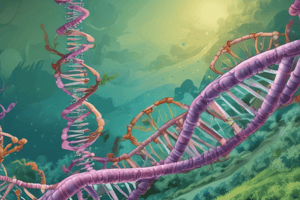Podcast
Questions and Answers
What is the term for the process of determining the locations of restriction endonuclease cleavage sites within a piece of DNA?
What is the term for the process of determining the locations of restriction endonuclease cleavage sites within a piece of DNA?
restriction mapping
Which of the following enzymes can relax supercoiled DNA?
Which of the following enzymes can relax supercoiled DNA?
- Topoisomerase (correct)
- T4 polynucleotide kinase
- Alkaline phosphatase
- DNA ligase
DNA replication occurs in the 3' --> 5' direction.
DNA replication occurs in the 3' --> 5' direction.
False (B)
______ is used to copy DNA in PCR or to fill in sticky ends.
______ is used to copy DNA in PCR or to fill in sticky ends.
What is the primary tool for genetic engineering of organisms?
What is the primary tool for genetic engineering of organisms?
The 1970s brought new methods of DNA analysis, making DNA one of the hardest cellular molecules to analyze.
The 1970s brought new methods of DNA analysis, making DNA one of the hardest cellular molecules to analyze.
What is the name of the anticoagulant antithrombin produced in transgenic goats?
What is the name of the anticoagulant antithrombin produced in transgenic goats?
__________ is used to treat lysosomal acid lipase deficiency, produced in transgenic chicken eggs.
__________ is used to treat lysosomal acid lipase deficiency, produced in transgenic chicken eggs.
Match the following restriction enzymes with their corresponding organisms:
Match the following restriction enzymes with their corresponding organisms:
Flashcards are hidden until you start studying
Study Notes
Recombinant DNA Technology
- Recombinant DNA technology involves combining sequences that aren't normally found together (e.g., human and bacterial DNA).
- It's used to manipulate genes for expression and regulation studies, overexpress products, study protein structure and function, sequence genomes, cure diseases, and create transgenic animals.
Molecular Cloning
- Molecular cloning involves splicing DNA sequences from two different sources (a genome and a vector) to form a replicon containing the gene of interest.
- The process involves:
- Isolating the gene of interest and generating fragments.
- Inserting the gene into a vector (e.g., a plasmid) to create a composite molecule.
- Introducing the composite molecule into living cells (e.g., bacteria) for propagation.
- Selecting cells that contain the gene of interest.
Cloning
- A clone is a collection of cells that are all descendants of the same cell.
- Gene cloning involves producing many organisms carrying a gene of interest for study, expression, or insertion into other organisms.
Transgenic Plants and Animals
- Plants can be genetically altered to be resistant to glyphosate, insects, and to grow larger or have increased vitamins.
- Animals can produce compounds like medicines, vaccines, and metabolites.
- Examples:
- Atryn, an anticoagulant, is produced in transgenic goats.
- Spider silk is produced in transgenic goats.
- Kanuma is used to treat lysosomal acid lipase deficiency and is produced in transgenic chicken eggs.
Gene Therapy
- Gene therapy involves using vectors to deliver therapeutic genes to cells.
- Achievements:
- Cured lung cancer in mice.
- Cured deafness in guinea pigs.
- Cured sickle cell disease in mice.
- Cured color blindness in monkeys.
- Cured hemophilia in sheep using gene therapy and stem cell transplantation.
- Cured Alzheimer's disease in mice using gene therapy.
Restriction Enzymes
- Restriction enzymes (endonucleases) cut nucleic acids at specific positions.
- They're used to analyze small genomes, distinguish or identify different DNA molecules, and verify insert directionality.
Restriction Enzyme Applications
- Restriction enzymes are used in:
- Restriction mapping to determine the locations of restriction endonuclease cleavage sites.
- RFLP (Restriction Fragment Length Polymorphism) to study inheritance, make pedigrees, detect disease markers, and in forensics.
- Molecular cloning to open up the field of biotechnology.
DNA Polymerase
- DNA polymerase is essential for DNA replication and many other proteins.
- It can be used to copy DNA in PCR or fill in sticky ends.
- There are several types of DNA polymerase, with different activities, locations in the replication process, and proofreading capabilities.
Proofreading and Primer Removal
- DNA polymerases have several domains: polymerase, 3'→5' exonuclease (proofreading), and 5'→3' exonuclease (primer removal).
- Taq polymerase lacks a proofreading domain.
- The Klenow fragment is a DNA polymerase I fragment that lacks the 5'→3' exonuclease domain.
- T4 DNA polymerase is used to remove 3' overhangs and fill in 5' overhangs due to higher activity.### DNA Polymerases
- coli DNA pol I: 3'→5' exo, 5'→3' exo, unstable at high temperatures
- Klenow fragment: 3'→5' exo, unstable at high temperatures
- Exo- Klenow: No exonuclease activity
- Taq: Very fast (~100 bp/sec), but makes ~1 in 9000 mistakes, adds A overhangs
- Pfu: Slower (~10 bp/sec) but makes only 1 in a million mistakes, produces blunt ends
- Taq/Pfu: 16:1 ratio improves PCR, can amplify long targets
- Phusion high fidelity: High speed and accuracy
- Hot start: Polymerases that are inactivated by an aptamer or antibody
DNA Modification
- 5' and 3' Overhangs: Sticky ends can be converted to blunt ends by Klenow or T4 (higher activity)
- Klenow or T4: Removes 3' overhang, fills in 5' overhang
DNA Ligase
- Restriction fragments with compatible termini (overhangs or blunt ends) can be spliced together by DNA ligase
- DNA ligase: Catalyzes 3'-5' phosphodiester bond formation
- Bacteriophage T4 DNA ligase: Often used due to ease of purification, stability, and affordability
- Reaction conditions: Room temperature, requires ATP in the buffer
DNA Ligase Mechanism
- Ligase: Forms phosphodiester bond using ATP
Other Important Enzymes
- Topoisomerase: Relaxes supercoiled DNA, used in TOPO TA cloning
- Alkaline phosphatase: Removes 5' and 3' phosphates from DNA to prevent ligation
- T4 polynucleotide kinase: Phosphorylates DNA at 5' for ligation, probes, removes 3' phosphate
- Reverse transcriptase: Generates cDNA from mRNA
Studying That Suits You
Use AI to generate personalized quizzes and flashcards to suit your learning preferences.




